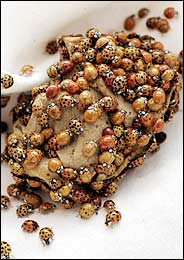 Asian lady beetles (Photo source: online version of article cited below, downloaded from: http://www.nytimes.com/2005/11/15/national/15bugs.html?pagewanted=1)
Asian lady beetles (Photo source: online version of article cited below, downloaded from: http://www.nytimes.com/2005/11/15/national/15bugs.html?pagewanted=1)
(p. A18) This Asian cousin of the benign, beloved ladybug has transformed domestic life in rural and suburban regions from Louisiana to Canada, intruding on the peace – and the attics, curtains and nostrils – of a significant swath of the nation.
Some years, the beetle problem is terrible. Some years, like this one, there are fewer beetles. But even so, in the 12 years that the beetle has spread from the South through the East and Midwest, irritation has given way to fury in its favorite wooded haunts.
“Please help us get rid of these bugs!” one Kentuckian commented on an anonymous survey by the University of Kentucky’s entomology department. “It’s so bad you can’t eat safely. They are falling into the food and drinks.”
A second person wrote, “A huge swarm enveloped my house last fall, causing me to fall off the porch and break my shoulder.” From a third came a cri de coeur: “Get rid of these pests. They are making me crazy. They have ruined my life.”
Unlike domestic ladybugs, the multicolored Asian variety likes to keep its polka dots indoors in the winter. In older rural neighborhoods, where houses are not knit tight, only insecticide can hope to keep them out. They swarm by the tens of thousands. Unlike the domestic ladybug, the Asian variety leaves a yellow stain. It can bite. Worst of all, it stinks.
. . .
It was for the benefit of farmers like the pecan growers that the Department of Agriculture released Asian lady beetles in the 1980’s in Georgia and elsewhere. The promise of aphid-free fruit trees and crops had prompted the department to try to import the bugs repeatedly, from 1916 on. But they never seemed to survive, until the early 1990’s.
A 1995 article in the journal Agricultural Research quoted William H. Day, a federal entomologist with the Agricultural Research Service, saying, “U.S.D.A. scientists have gone overseas for more than 100 years to search for, test, import, rear, release and evaluate exotic beneficial lady beetles, parasitic wasps, other insects and microorganisms.”
FELICITY BARRINGER. “Asian Cousin of Ladybug Is a Most Unwelcome Guest.” The New York Times (Tuesday, November 15, 2005): A18.
(Note: ellipsis added.)
